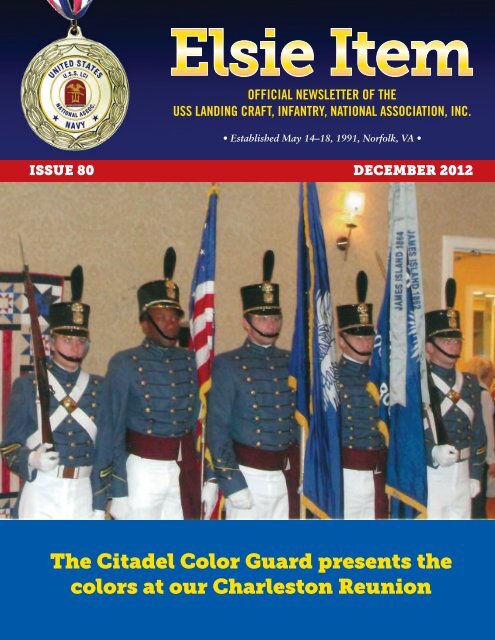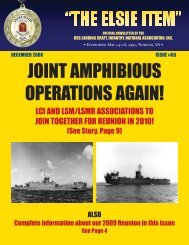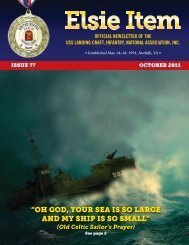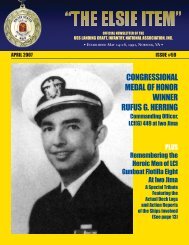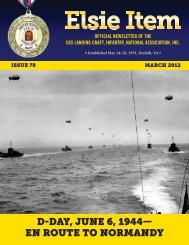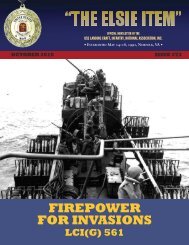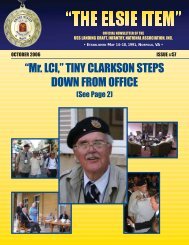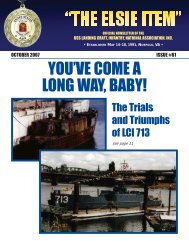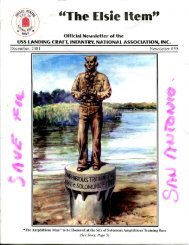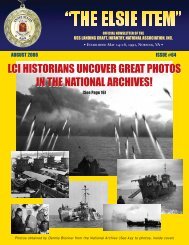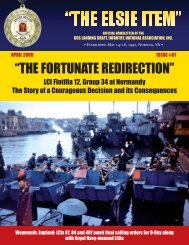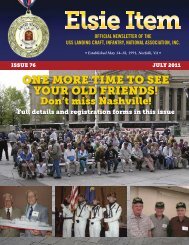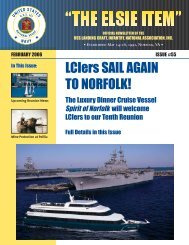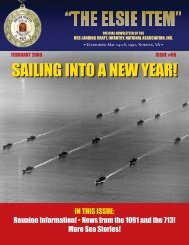elsie item issue 80 dec 2012 - USS Landing Craft Infantry National ...
elsie item issue 80 dec 2012 - USS Landing Craft Infantry National ...
elsie item issue 80 dec 2012 - USS Landing Craft Infantry National ...
- No tags were found...
Create successful ePaper yourself
Turn your PDF publications into a flip-book with our unique Google optimized e-Paper software.
OFFICIAL NEWSLETTER OF THE<strong>USS</strong> LANDING CRAFT, INFANTRY, NATIONAL ASSOCIATION, INC.• Established May 14–18, 1991, Norfolk, VA •ISSUE <strong>80</strong> DECEMBER <strong>2012</strong>The Citadel Color Guard presents thecolors at our Charleston Reunion
A Word from thePresident/EditorI need to begin with an apology to you for the lateness of this <strong>issue</strong>. It should havebeen out in October, but a series of events and concerns got in my way a bit morethan usual this time. Thank you for your patience. I’ll try to do better next time.It’s been a time when, with input from many of you, the Board has been wrestlingwith questions concerning the future of our association. Within the next two yearswe want to see the leadership transition to those of you who did not serve in LCIs during WWII, but, who, by theirnumbers and enthusiasm, promise a bright and strengthened association molded to serve their interests. No doubtmany of our “old timers” will be with us for many years, but remembering the LCI legacy certainly lies with this nextgeneration.The Transition Task ForceBetween now and our next reunion, which will be scheduled for the fall of 2013, a Transition Task Force [TTF],made up of our younger generation members already serving in leadership roles will be activated. The role of this TTFwill be, first of all, to nominate from their ranks the persons they want to move into the office of President and VicePresident. These nominees would take over at the Branson reunion and I, as outgoing President, would move into anadvisory role for the new President for the following year. John France, our present Vice President could advisehimself! The office of Treasurer, currently held by Hal Bleyhl, is an appointed office, so the TTF could do theappointing. Hal would continue in an advisory capacity for the following year.The other role of the TTF would be to think through and plan any changes they think should be made. They woulddeal with such questions as:• Do we want to continue with annual reunions?• Should Elsie Item continue in print format or move to an electronic publication?• Should the web page be continued as is or are there changes that should be made?• What does the financial future look like? Do we need to change our dues structure?These questions listed are not exhaustive but illustrative. The results of their deliberation could then be presentedat the time of the Branson reunion in the Fall of 2013.Parting Ways with the LSM/LSMR Association.Issues concerning the time and place of future reunions with the officers of the LSM/LSMR Association were suchthat, reluctantly, it was <strong>dec</strong>ided that we should go our separate ways in the future. We will try as hard as we can topromote attendance at future reunions to make up for the loss in numbers as a result of this separation.Planning for Two YearsAfter extensive discussion, The Board of Directors has <strong>dec</strong>ided to plan for the next two reunions and, in the process,make a <strong>dec</strong>ision about any future reunions after 2014. Consequently, the plan will be to hold our next reunion in the2 | ELSIE ITEM | December <strong>2012</strong>
fall of 2013 in Branson, Missouri, and, what could be our last reunion, in the spring of 2013 in Portland, Oregon withthe <strong>USS</strong> LCI(L) 713 once more being the chief attraction.Branson was <strong>dec</strong>ided upon because of the wonderful hospitality to Veterans that city offers and because of its morecentral location.Why Portland? As you will read elsewhere in this <strong>issue</strong>, the hard-working volunteers of the Amphibious ForcesMemorial Museum have made great progress in the restoration of the 713. Setting our reunion for the spring of 2014would give them incentive to have it in an even more pristine condition by that time, possibly even with engines reinstalled.If, indeed, it is our last reunion, the opportunity to once more tread the steel <strong>dec</strong>ks of the ship would be agreat last memory.Dates for both of these reunions will be announced in the near future.Other newsWe urge you to read this <strong>issue</strong> carefully as it contains important news about several <strong>item</strong>s of interest, i.e., thearticle on the donation of our archives to the Admiral Nimitz Museum of the Pacific and the significant progress beingmade on the restoration of the 713 in Portland.Any more Sea Stories?We’re always on the lookout for more sea stories to share, so if you have one, send it in and we’ll be glad to considerit for a future <strong>issue</strong>. Share your personal legacy!—John Cummer“THE ELSIE ITEM” NUMBER <strong>80</strong>, December <strong>2012</strong>Official publication of the <strong>USS</strong> LCI <strong>National</strong> Association, a non-profit veteran’s organization. Membership in the <strong>USS</strong> LCI<strong>National</strong> Association is open to any U. S. Navy or U.S. Coast Guard veteran who served aboard a <strong>Landing</strong> <strong>Craft</strong> <strong>Infantry</strong>, toanyone related to an LCI veteran, or to anyone just interested in the history of LCIs. Published quarterly by the <strong>USS</strong> LCI <strong>National</strong>Association. John P. Cummer, Editor. Any material for possible publication should be sent to the Editor, preferably by email(cummerj@bellsouth.net) or by regular mail to 302 Pinewood Cottage Lane, Blythewood, SC, 29016.On Our Cover:No more impressive color guard has been seen at our reunions than that of The Citadel,The Military College of South Carolina.December <strong>2012</strong> | ELSIE ITEM | 3
The Charleston Reunion!See more photos ofthe reunion – page 25The <strong>USS</strong> Lexington atPatriots PointHal Bleyhl and JohnCummer get ready forthe banquetThe onlyway to seeCharleston!Historic Fort Sumter in Charleston Harbor4 | ELSIE ITEM | December <strong>2012</strong>
The Charleston Reunion:Another Great OneHistoric Charleston provided a great venue for the 114 LCIers and 126 LSMers who gathered September 10-13for our <strong>2012</strong> reunion. A fine hotel and the city’s renowned hospitality were enjoyed as old shipmates enjoyedeach other’s company and reminisced about their past exploits.An informal reception on Monday, September 10th started the festivities as old shipmates and their friends andfamilies greeted each other. On Tuesday the group enjoyed a bus tour of the city where history seemed to greet thevisitors on every corner. From the Military College of South Carolina, better known as The Citadel, to the Battery wherethe opening shots of the Civil War were fired at Fort Sumter, the tour concluded with a stop for lunch at the CityMarket, which has been in continuous operation since the 1700s. Here we had our first opportunity to enjoy thefamed cuisine of Charleston. Many, for the first time, learned how good such delicacies as she-crab soup, crabcakes, shrimp and grits were.An evening cruise aboard the Spirit of Carolina provided another opportunity to enjoy that wonderful food whileenjoying the sights of Charleston’s harbor. As the sun set, the cruise vessel circled historic Fort Sumter where theCivil War began.Yet another opportunity for sight-seeing and good food came on Wednesday when the LCIers enjoyed a tour ofPatriot’s Point, home of the largest naval and maritime museum in the world. Aboard the <strong>USS</strong> Yorktown, famed WWIIaircraft carrier, the sight-seers saw war planes used during wars and conflicts spanning from WWII to OperationDesert Storm. Of special interest was the official Medal of Honor Society Museum. Information and photos of allDecember <strong>2012</strong> | ELSIE ITEM | 5
Medal of Honor winners is available there. An inquiry at the desk brought out the citation and photo of LT RufusG.Herring, CO of <strong>USS</strong> LCI(G)449 during the pre-invasion attack on Iwo Jima, February 17, 1945.Following the tour of Patriot’s Point the group had lunch at the Charleston Crab House, yet another memorablegustatory experience!Thursday the reunioners took part in the annual business meeting, memorial service and, as a culmination ofanother great reunion, enjoyed a sumptuous banquet. You will read accounts of each of these events elsewhere inthis <strong>issue</strong>. You’ll read more details about each of these activities elsewhere in this <strong>issue</strong>.The old cliché was true once more: “A great time was had by all!”Royal Wetzel Enjoys the Reunion!ByJoe FlynnAll hands had a good time at ourCharleston reunion, but if a prize were tobe awarded for the LCI Sailor having themost fun, Royal Wetzel, cook of the LCI70 would have won hands down!Roy shared the fun by distributingKazoos and recruiting a Kazoo MarchingBand. He also brought with him somePennsylvania sausage, cheese andcrackers. Once a cook always a cook andRoyal can't stand to see anyone go hungry.Roy Wins the LSM “50-50” RaffleAnd in the most fun category, there was athree-way tie for second place shared by the Wright brothers; Bill, Richard, and Robert Jr.The Kazoo players entertained in the Hospitality Room, the Lobby, and with the music and entertainment thatfollowed the Banquet.While the Association does not award a prize for having the most fun, Royal did receive a prize at the Banquet -- hewon the LSM-LSMR 50-50 drawing. He was a winner all the way around and is already planning for next year.6 | ELSIE ITEM | December <strong>2012</strong>
CAPT, Chaplain, Michael LangstonAddresses BanquetFeatured speaker at the LCI Reunion Banquetwas recently retired Captain, Chaplain,Michael W. Langston, whose last Navyassignment was Commanding Officer of theNavy Chaplaincy School and Center at FortJackson, Columbia, SC, where the chaplaincytraining programs for all U.S. Military Serviceswere recently combined.A former line officer in the U.S. MarineCorps, Captain Langston resigned in 1983 topursue studies at Southeastern BaptistTheological Seminary. After pastoring achurch in Brevard, NC, he was recalled toactive duty from the Navy Reserve as aChaplain. During his career as a NavyChaplain, he served with units in OperationDesert Storm and as Force Chaplain for IIMarine Expeditionary Forcein Al AnbarProvince, Iraq.For his LCI audience, Chaplain Langstonrecounted some of his experiences inamphibious warfare during his service withthe Marines. He commended LCI Veterans fortheir service and urged them to “finish well”during their senior years.Having met Chaplain Langston at a meeting of men of the church, President John Cummer invited him to speak atthe LCI banquet, feeling he had much to share with that audience. Chaplain Langston is now serving as Professor ofChaplaincy at Columbia International University in Columbia, SC.December <strong>2012</strong> | ELSIE ITEM | 7
LCI Association Archives to be donated tothe <strong>National</strong> Museum of the Pacific WarThrough the efforts of Dennis Blocker, our historian for the Pacific Theater of War, and with the approval of the Boardof the <strong>USS</strong> LCI <strong>National</strong> Association, arrangements have been made to have the <strong>National</strong> Museum of the Pacific Warand the Admiral Nimitz Foundation to be the recipients of our Association’s Archives. This collection includeshundreds of documents and photographs that Dennis has collected and cataloged. At the museum they will be caredfor by professional archivists and will be available to the public as well as to scholars doing research.A special presentation is being planned for March 9, 2013, and it is hoped that as many LCI Veterans as possiblewill be able to attend. The museum is located in Fredericksburg, Texas, 70 miles from San Antonio, where Dennislives, making it very convenient for him to continue working with the collection.Fredericksburg was the home of famed WWII Admiral Chester W. Nimitz and so focuses on the war in the Pacific, butthe archivists have said they will be delighted to also house and service our materials dealing with the EuropeanTheater of Operations.8 | ELSIE ITEM | December <strong>2012</strong>
Nimitz Museum <strong>issue</strong>s Press Releaseon Donation of LCI ArchivesThe following press release has been prepared to publicize the donation of the LCI Archives to the museum:“<strong>USS</strong> <strong>Landing</strong> <strong>Craft</strong> <strong>Infantry</strong> Association to Donate Archives to the <strong>National</strong> Museum of the Pacific War“The <strong>USS</strong> <strong>Landing</strong> <strong>Craft</strong> <strong>Infantry</strong> <strong>National</strong> Association has chosen the <strong>National</strong> Museum of the Pacific War and theAdmiral Nimitz Foundation as the recipients of their entire achieve collection. There are hundreds of Action Reportsand War Diaries from the invasions of D-Day on Omaha Beach to Salerno, Sicily, Anzio, Tunisia, Kwajalein, Eniwetok,Saipan, Guam, Tinian, New Guinea, Philippines, Iwo Jima, Peleliu, Okinawa and various other places from Alaska toAustralia and all places in between. The archives also hold over 1,000 photos of the LCI, some scanned from the<strong>National</strong> Achieves.“The <strong>National</strong> Museum of the Pacific War located in Fredericksburg, Texas will accept the donation at a specialprogram scheduled for March 9, 2013 starting at 1:30 pm in the Ballroom of the Nimitz Hotel. This program will beopen to the public and all are invited to attend and take part in this historic event. The program will havepresentations delivered by members of the LCI Association, LCI veterans, John Cummer and Larry Hermes, and LCI<strong>National</strong> Association Board Member Dennis Blocker, grandson of a WWII LCI veteran.“What is an LCI? “<strong>Landing</strong> <strong>Craft</strong> <strong>Infantry</strong> were and are ships designed to deliver fighting troops to a beach quickly.WWII LCIs had a crew of 24-60 sailors and carried 200 soldiers, who descended from ramps on each side of the craft.They weren't designed cross-ocean travel -- yet given the urgency of wartime, they did just that, sailing from theUnited States to the European and Pacific Theatres. Their flat-bottom hulls were designed for beaching, which meantyou felt every wave and more than one sailor and soldier ended up donating his lunch to the sea on a continuousbasis.“For more information on the <strong>National</strong> Museum of the Pacific visit www.pacificwarmuseum.org or call (830)-997-8600.“The <strong>National</strong> Museum of the Pacific War is a Texas Historical Commission property supported, operated, andmanaged by the Admiral Nimitz Foundation.”December <strong>2012</strong> | ELSIE ITEM | 9
You can have a Part in Establishing theLCI Archives at the Nimitz Museum!Pacific War Historian Dennis Blocker is working on a project which will add greatly to the presence of the LCIArchives at the Nimitz Museum of the Pacific War. He is culling through the hundreds of LCI photos he hascollected from the <strong>National</strong> Archives and elsewhere to pick out what he considers to the be the best one hundredof them. His aim is to have a display of these pictures, suitably mounted for display in the museum.. Dennissays, “On the back of each print I will acknowledge the family or individual who will donate $5.00 to this project.The label will say, for example,“This print is made possible by a donation from the ___________ family in honor of their (father/grandfather,etc.) who served on LCI _______ during World War II.”Or“This print is made possible by a donation from __________________ who served aboard LCI _______during World War IIDennis will search to see if there is a picture of the LCI on which the person served and, if there is one, will usethat print for that individual. If none is available, the label will be placed on another photo. The photos will be8½ by 11,” black and white, professionally mountedIf you are interested, please contact Dennis.Dennis Blocker6138 Border Trail,San Antonio, TX 78240Telephone: 210/396-8872Email: lci449@ yahoo.com10 | ELSIE ITEM | December <strong>2012</strong>
A Selection of Picturesfrom the LCI ArchivesTo give you an idea of the kind of pictures that have been collected into our archives, here are some that we thoughtyou might enjoy seeing. (Photos continue on the following two pages.)LCI 618. This picture wastaken after the war wasover as U.S. Marines movedto secure positions ofimportance in Tientsin,China. Crowds of Chinesepush and shove to catch aglimpse of the Americanship with U.S. Marines.Normandy Beach. Ahaunting picture takenfrom a German artillerybunker. Looking straightdown the barrel, you willsee the unmistakablesilhouette of an LCI.December <strong>2012</strong> | ELSIE ITEM | 11
LCI(G) 69. LT9jg) Homer Rosetti (wearing helmet) treats leg wounds on one of his crew.Notice the tourniquet which has been applied to the man’s thigh to stem the flow of blood.12 | ELSIE ITEM | December <strong>2012</strong>
LCI 775. The crew work against the elements to pry LCI 775off the beach at Point Hueneme, California 21 Nov. 1944.New Guinea OverviewShot. A U.S. Planegets a great shot of UStroops debarking LCIsduring the invasion ofMorotai. Note theclouds of muddy waterbeing kicked up by thetroops s they trudgetoward shore.December <strong>2012</strong> | ELSIE ITEM | 13
Great Progress in theRestoration of the 713!The 713 looked great when we first saw her at the 2004 reunion, better still when we saw her again at our 2009reunion and will look even better when we see her in 2014! From a rusty hulk that had sat on the bottom of the riverfor years she has, by the dedication and hard labor of a crew of volunteers, made great progress in being restored toher pristine WWII shape and appearance.The Amphibious Forces Memorial Museum’s restoration crew, under the leadership of their President, Rick Holmesand Chairman of the Board, Gordon Smith, has been responsible for significant improvements during the past year.As the restoration work continues there is more and more evidence of the growing sophistication of the organization.With a membership of over 400, the museum is now debt free and, as President Holmes puts it “...in firm control ofour own destiny.” After some legal difficulties with the previous owner, AFFM is now sole owner of the 713.The 713 was saved from possible serious damage by a fortuitous <strong>dec</strong>ision to change her mooring. Shortly after themove to a new location on nearby Hayden Island, a fire destroyed the Thunderbird Inn where she was moored. Theentire motel, which was vacant and had been on the market, was totally destroyed by the fire that took two days toextinguish. Though less accessible now, she is conveniently located near repair facilities and arrangements havebeen made for visitors to reach her by boat. Rick Holmes reports that they have several excellent prospects for a newpermanent home which they hope to secure over the next year or so. This could mean that the ship would be much14 | ELSIE ITEM | December <strong>2012</strong>LCI 713 at the Portland Reunion, 2004
more accessible when we have our 2014 reunion there.Another mark of progress is the introduction of a quarterly newsletter published on the network but also available inhard copy for those without computer access. This newsletter is available on the museum’s websitewww.amphibiousforces.org.The list of restoration work done during the past year is impressive. Due to environmental restrictions, the crew hasbeen restricted to doing job mostly inside the ship, but, as Rick reports “that still leaves a whole host of things to do!They have lagged and painted overheads and bulkheads of all interior spaces; repaired the after steering escapehatch (which has not been operable for several years); installed of a fire pump and fire main system; made troopcompartment 2 into a museum display area; restored the small arms locker in the passageway by the officer’s headand a gunner’s tool cabinet in the foc’sle; and, perhaps most impressive, have obtained <strong>dec</strong>k winches for the well<strong>dec</strong>k and the fantail. Master Mechanic Woody Woodruff has both winches in running order. Main engines, previouslyobtained but not yet installed, are also in running conditions.The ship is in need of extensive bottom repairs but, as soon as funds are available, the steel, which has alreadybeen purchased for the job will be installed. When that is accomplished and the engines installed, the 713 will beable to get underway on her own power. That very well could be in time for our 2014 reunion!Perhaps the most significant challenge for these dedicated restoration workers is fund raising. A professional fundraiser and grant proposal writer will be hired to get help with the larger restoration projects, but the gifts ofindividuals, such as LCIers, are important because grants most often require matching funds.One way in which LCIers and their friends and family could help meet these financial needs would be to participatein the Life Jacket Memorial Program. For a $250 donation, AFFM will permanently mount an authentic Navy <strong>issue</strong>kapok life jacket with steel brackets to the overhead in compartments throughout the ship, including crew’s mess,officer’s staterooms, the wardroom, crews quarters, and troop compartments. A gold aluminum plate mounted on anoak or mahogany strip bearing the donor’s name and up to three lines of text will be attached to the brackets to holdthe life jacket. This method of storage will be just as it was during WWII. You may contact AFFM on their website formore information on this program.“Our end goal,” says President Holmes, “is a fully operational ship and we have plans in place to make it happen.But we will need help. Larger projects require larger grants which in turn require matching funds, so if anyone in the<strong>USS</strong> LCI <strong>National</strong> Association, has foundation, corporate or other contacts, we ask that you please considerrecommending the AFFM.”Amphibious Forces Memorial Museum to have direct access to all documents and photos;also chosen to receive Physical Memorabilia.The Directors of the Armed Forces Memorial Museum, home of <strong>USS</strong> LCI 713, have indicated that they would likedirect access to the documents and photos going to the <strong>National</strong> Museum of the Pacific. Accordingly, DennisBlocker is supplying them with electronic copy of all material being given to the <strong>National</strong> Museum of the Pacific.Additionally, the Board of Directors has designated the Amphibious Forces Memorial Museum as the recipient ofall physical memorabilia associated with LCIs. Space aboard the 713 as well as at other places to which AFFMmight expand will provide excellent display space.December <strong>2012</strong> | ELSIE ITEM | 15
A WORD FROM CHAPLAIN MIKESweetgrass Basketsand Shipmates(Editor’s Note: Each year Chaplain Mike Gatton selects some feature from the local culture where our reunion is beingheld and uses it as a theme for his remarks at our memorial service. In Portland, it was a rose for their Rose Festival; inCincinnati it was stones representing the seven hill upon which the city was built; in Nashville, it was a guitar for thatcity’s country music tradition. This year he chose sweetgrass baskets, a low country South Carolina art form. We want toshare what Mike said with you who were unable to be there.)(As requested by so many of those present at this year’s Memorial Service in Charleston, it is my honor to share thesethoughts in memory of shipmates and friends.)You have been born anew, not of perishable but of imperishable seed,through the living and enduring word of God. For “all flesh is likegrass and all its glory like the flower of grass. The grass withers andthe flower falls, but the word of the Lord endures forever.”—1 PETER 1: 23-25Charleston sweetgrass baskets date back over 300 years. The traditionwas brought here by slaves from the West African Rice Coast and is animportant craft and art form to the Gullah people of Charleston. TheGullahs are proud descendants of those slaves. Since this year’s LCIReunion was held in Charleston, South Carolina—the Low Country andhome of the Gullahs—it is only fitting that their culture be used toremind us of departed shipmates.Sweetgrass is a grass that grows in the space between land andsea—the very place where LCI sailors served their country. It serves tolink one element to another—a living connection between earth andwater. Standing on separate shores, we, the living, are always seekingunity between life here and life eternal. Since sweetgrass grows on theCarolina coast as well as the shores of Africa, it was a welcome culturalconnection to the slaves’ homeland and a reinforcement of their faith inthe God of their salvation. Sweetgrass connects us as an LCI family andreinforces our faith in God.A Gullah sweetgrass weaver demonstratesher art at our memorial service.Because the grasses used in the baskets are from swamps and marsh area, water will not hurt them. They areresilient. We pay tribute to a generation born during a Great Depression, tempered by a World War, nurtured by hardwork, challenged by a changing nation, and slowed by failing bodies, but whose spirit lives on. They are resilient.Because of their faith and ours, not even death can have the final say.16 | ELSIE ITEM | December <strong>2012</strong>
Sweetgrass baskets are woven in coilsand use whatever resource is at hand—sweetgrass, bulrush, pine nettles—there isnothing wasted. The beauty of their designis found in the variety of their materials.This generation used what they had athand. They found a way to do more withless. They taught us about teamwork—that together we are stronger than we couldever be apart. We give God thanks for theirstrength which is woven into our lives.Baskets originally were made as tools forwinnowing and hauling rice and otherproducts. After the 1890s, sweetgrassbaskets began to evolve from agricultural implements to household <strong>item</strong>s. From humble beginnings this generationworked to protect and build a nation. They won a war then came home to start careers and raise families. We are whowe are because they were who they were.Each sweetgrass piece is unique, and each artist develops his or her own style. Baskets require a great deal of patienceand creativity, as there are no set patterns. In the same way, there is no set pattern in human personalities—each personis unique—each has his or her own style. As each blade of this grass is the same yet different, so we celebrateexperiences shared and remember what made each of these men special.Basket making is learned from childhood and is handed down from generation to generation. We are thankful for thecommitment to God, family, and country exemplified by these men. They taught us about duty and honor and personalresponsibility. We are forever grateful for examples set and lessons learned.Sweetgrass is temporal—it sprouts and grows and dies. But, basket sewing is a way of making what is here today,but gone tomorrow into something eternal. The basket is a gift from God as are these friends we remember today.People die—love is eternal. <strong>Craft</strong>ed by the hands of our Creator, we treasure their time among us. Each of these friendsand shipmates we celebrate as a gift from God. They belong to God today.Agape, MikeSweetgrass basketsare an art, not a craft!December <strong>2012</strong> | ELSIE ITEM | 17
IN MEMORIAM“Almighty and eternal God, from whose love we cannot be parted, either by death or life;hear our prayers and thanksgiving for those whom we here remember.”“Grant unto sorrowing family and shipmates the blessingof your peace that passes understanding.”We honor here those shipmates who havepassed on since the publication of our last <strong>issue</strong>:LCI 43Fred CaciciLCI 70Harold CroninLCI 407Lewis “Chick” MasonLCI 450Vaughn HamptonLCI 710Frank J. Ruxlow, Jr.LCI 1062Clyde Allen18 | ELSIE ITEM | December <strong>2012</strong>
John France Trains theKenya Wildlife Service Patrol!LCI Association Vice President John France has recently returned home after three months in Kenya training theirWildlife Service Patrol. The son of LCIer Frank France, who served on LCI 540, John came out of his retirement as asupervisor in the U.S. Border Patrol, to take on this assignment at the request of the government of Kenya.Though John had plenty of experience in “chasing bad guys around the Arizona desert”, as he put it, he experiencedsome new challenges in Kenya. John emailed, “The firing of blanks through rifles to chase away the elephants is anightly ritual that you can almost set your watch by.”At night John had to walk a couple of hundred yards back to his little house with his flashlight and “It is amazinghow an elephant can get within fifteen yards of you at night without you seeing it” he said.John reports that he had a great time during this assignment, but is now glad to be back “in the good old USA!”December <strong>2012</strong> | ELSIE ITEM | 19
<strong>USS</strong> LCI(G) 821:First into SecretJapanese HarborBy A.A. Mayer, Quartermaster 3/C.One of the most difficult assignments given to LCI Gunboats was picket duty in the Palau Islands. The famous“Black Cat Flotilla”, Flotilla 13, was assigned the role of preventing the infiltration of Japanese troops from the northand, as such, they were the target of innumerable suicide swimmer and boat attacks. In September, 1945, <strong>USS</strong> LCI(L)821 was ordered to enter Malakal, a former secret Japanese harbor. As such they were the first U. S. Navy ship toenter this anchorage. This account was carried in the history of <strong>USS</strong> LCI(G) 821, assembled by Ronald L. Risch, son ofWilbert “Johnny” Risch who served as a Gunner’s Mate aboard the 821.Shortly after the surrender of Malakal, Our LCI(G) was standing about two thousand yards off the entrance ofMalakal Harbor when the skipper said, “Let’s go. Left full rudder!” The ship swung slowly around and so beganthe first American ship’s passage into the secret harbor of the Japanese stronghold in the Palau Islands.As the ship’s head steadied down on course, I could feel a certain tenseness in the atmosphere on the bridge. I guesseveryone on the conn felt the same way, a bit keyed-up and excited. In fact, the air seemed electrically charged.We moved in slowly, hugging the north side of the entrance channel with the steep cliffs of Malakal Island hoveringover us. Yes, there were mines, plenty of them. The Japanese Naval Officer in charge of Malakal Harbor had comeaboard from a Daihutsu and had given us valuable information concerning these mines, but as to where they were inthe channel, he was not certain.The ship edged forward and rounded the tip of Ngarroll Island into the harbor. Through a fine drizzle of rain we hadour first good view of the once thriving secret harbor. Fortunately, the water was very calm and I managed to satisfymy curiosity with quick glances here and there while keeping an eye on the gyro repeater.Malakal Harbor is a beautiful place, surrounded by steep green hills which afforded ample protection from theheavy seasonal winds and seas of this area. The results of our carrier strikes was to make it a graveyard of shipsboth small and large. Some were completely out of the water, but still resting on the bottom, while others werecompletely submerged. Occasionally we saw a lone mast or two which would serve as a warning that, below, lies aonce proud man-of-war.Suddenly Captain Roberts ordered, “Right full rudder,” indicating that we were quite near a sunken wreck. After allwas clear ahead we began observing docks, emplacements, and once prosperous warehouses. Moving as close toshore as safety would permit, we rounded a sharp turn marked by a half-destroyed concrete navigational beacon.Nothing but ruins could be observed on shore. Our Air Force had taken care that the Japanese had little or nothingthat they would want to keep.Out of the corner of my eye I could see Commander Brown and Captain Roberts talking. The next order, casually given,was one for history for the 730. It was, “Special Sea Detail”. Then through megaphones on the bridge came shouts to all20 | ELSIE ITEM | December <strong>2012</strong>
Seaman First Class Johnny Risch (fourth from the left) stands between his mates on number three gun, Buddy and Earl Tennermannto receive Purple Heart medals at a ceremony aboard LCI(L) 821, 4 August 1945. These men were wounded in action on 7 May 1945at Palau Islands while defending one of the picket lines against infiltration by the Japanese.the crew, “Port Side to”. That meant one thing; we were going to dock. Our men jumped to the dock immediately uponcoming close enough to handle their own lines. They were probably the first Americans to set foot on Malakal Island.With the ship secured all had to go ashore and see what it had to offer. Elsie and Midnight, Flotilla Ship’s mascots,were bouncing through the grass before anyone else though of leaving the ship. We observed ruined machinery, bombpits, scattered debris, and strafed oil drums. A few Japanese met us with profuse slauting an bowing. They wantedcigarettes; we wanted souvenirs. Both were eventually satisfied.Our Ensign and our Flotilla Flag proudly flew from the mast. All three absentee pennants were immediately blocked.Flotilla Thirteen had taken over Malakal. The Japanese were no longer in charge. America was the Victor!The entrance of LCI Gunboat 730 into Malakal was the crowning climax to a whole year of the steady, monotonouswork of picket and patrol duty by LCI(L) Flotilla Thirteen.Later, underway out of the harbor, it occurred to me that we and all the ships in the Palau area had added asentence to the history of the Navy’s efforts to keep freedom and peace throughout the world, show power and putdemocracy upon the seas.December <strong>2012</strong> | ELSIE ITEM | 21
22 | ELSIE ITEM | May 2011
May 2011 | ELSIE ITEM | 23
Can You Top this Sea Story?A memorable anecdote from William H. McCracken. <strong>USS</strong> LCI(R) 1030Somewhere, out there, we know that there are dozens of great sea stories that have never been published, here orelsewhere. We dug this one out of the first volume of our history published by Turner Company as a challenge to allyou old salts. Can you top this? If so, send it in so we can share it with all our shipmates!LCIs in World War II were unfortunately doomed to bear the cross of procuring, often begging, survival suppliesand nourishment from any nearby larger naval vessel, frequently cargo AGCs: engine parts, ammunition, toiletpaper, fuel oil, meat, two-year old eggs, beer. LCI survival was frequently supported by negotiated barter exchangesamong sister ships, involving unexplainable excess ten year inventories of, say, frozen chicken feet and rustproofingpaint that no one wanted to put on anyway.Beer, in the U. S. Navy Pacific Theater, was carefully controlled, protected, guarded, regulated, preserved andrationed by the big ships and, despite its tremendous role as a morale-builder, in the end the LCIs – at the bottom ofthe totem pole – got like nothing.Once upon a time, in July, 1945, six months dry and very, very thirsty, two successfulinvasions under their belt, now in Buckner Bay amid the Kamikazes at Okinawa, acompassionate AGS Executive Officer grudgingly let the LCI(R) 1030 have two cases ofbeer. What may have been contributed in exchange by the 1030 was undoubtedlypriceless, very important, and cannot be discussed here in writing.Unfortunately, the LCI’s homemade 10 foot dinghy with oars, temporarily powered bythe ship’s borrowed washing machine motor, capsized bottoms up while loadingalongside the AGC. Everything and everybody went into the water immediately losingall supplies except for one case of beer tightly gripped with a stranglehold between mylegs, all the while bobbing up and down in six foot waves and trying to retrieve andhang on to my cap. The two accompanying 1030 Machinist Mates lost their fuelinjectors, their enthusiasm and their sense of humor.The kind, good-hearted AGS promptly replaced each lost supply <strong>item</strong>, except the lost case of beer. So, back at theship, with the entire crew lined up on the railing as a welcoming committee, I thought “How do you divide up 24bottles of beer among 36 sailors who haven’t had a drop since Pearl Harbor six months ago?” For my efforts, thisconscientious, well-intentioned Supply Officer was almost lynched in effigy.Four months later in Sasebo, Kyushu, Japan, the war won and a typhoon successfully fought,a newly-arrived AGCresponded to the humble request for essential survival commodities and beer by asking, “How much do you want?”One hour and a borrowed LCVP later, we heroes re-boarded good old LCI (R) 1931 with 240 cases of the stuff!We partook and quenched our thirst prudently and respectfully for three days, even saving some for the slow journeyback to San Diego through Saipan and Pearl Harbor. Although tightly secured in the aft ammunition locker, some ofit, somehow, sort of evaporated or something during the return journey. In any event, ship’s morale reached newheights in Sasebo, and the war could easily have been won again. The Supply Officer was subsequently andunanimously awarded the Distinguished and Malted Order of Outstanding Achievement in the field of Vessel Moraleand Well-Being.Nothing since has been so satisfying!24 | ELSIE ITEM | December <strong>2012</strong>
The Charleston Reunion in PicturesHistoric downtown CharlestonChaplin Mike Gatton presides at thememorial serviceGordon Smith is honored for his long service to the LCI Associationand the Amphibious Forces Memorial MuseumJohn Cummer, Penni Breivik and Robert Wrightenjoy a few minutes before the banquetDecember <strong>2012</strong> | ELSIE ITEM | 25
<strong>USS</strong> LCI NATIONAL ASSOCIATIONAPPLICATION FOR MEMBERSHIPOur membership is open to anyone who served in <strong>Landing</strong> <strong>Craft</strong>, <strong>Infantry</strong>, during WWIIor anyone else interested in our small ships and the men who served aboard them.Please complete this form and mail it to the address indicated below with your first year’s dues.DUES ARE $25.00 PER YEAR, June 1 through May 31.I. For application as a LCI Veteran:Name______________________________________________________________________________________Which LCI did you serve on?___________________ What was your Rank/Rate?____________________Address:___________________________________________________________________________________City: _______________________________________ State:__________ Zip:_________________________Date of Birth:________________________________ Phone #:________/____________________________E-mail address:_____________________________________________________________________________Occupation or Former Occupation: ____________________________________________________________Wife’s Name________________________________________________________________________________II. For Application as a Relative or Interested Person:Name______________________________________________________________________________________Address:___________________________________________________________________________________City: _______________________________________ State:__________ Zip:_________________________Date of Birth:________________________________ Phone #:________/____________________________Are you related to someone who served on an LCI? o Yes o NoIf so, what is the relationship? (i.e. father, grandfather, uncle, etc) _______________________________What is/was his name? _____________________________________________________________________On which LCI did he serve? ____________________(If unknown or if you do not have a relative who served on an LCI, leave blank)Please send this application with your check ($25) made payable to<strong>USS</strong> LCI NATIONAL ASSOCIATION to:<strong>USS</strong> LCI <strong>National</strong> Associationc/o Nehemiah Communications, Inc.101 Rice Bent Way, Unit #626 | ELSIE ITEM | December <strong>2012</strong>
Your Officers and Board of DirectorsPlease feel free to contact any of the officers or directors listed below for whatever comments or questions you may have. If theperson you contact does not know the answer to your question, he will direct you to one who can. We’re here to serve you!OFFICERS:James E. TalbertChairman of the BoardLCI 61812238 Woodland TrailCouncil Bluffs IA 51503(712)366-1094tab626@yahoo.comJohn P. CummerPresidentLCI 502302 Pinewood Cottage Lane,Blythewood, SC 29016(<strong>80</strong>3)714-9098cummerj@bellsouth.netJohn FranceVice President11621 Copper Springs TrailOro Valley, AZ 85737(520)429-3792Lci540@aol.comHal BleyhlTreasurerLCI(L) 81210418 Campville St.Boise, ID 83709(208)639-91<strong>80</strong>hbleyhl@aol.comSteven DudrowSecretaryAssociate Member5067 Vincitor Street,Las Vegas, NV 89135(941)416-0717stevedudrow@comcast.netRev. David CoxChaplain(LCI 633)413 Tupilo Way NWBirmingham, AL 35215(205) 854 -5229swabby1@bellsouth.netRev. Michael GattonChaplainAssociate Member6410 Gellhaus LaneLouisville, KY 40299502/762-0613mgatton@insightbb.comBOARD OF DIRECTORSJim Aydelotte(LCI 25)3710 Goldfield Road #425Apache Junction, AZ(4<strong>80</strong>-671-2425)Jj10723@aol.comDiane CroninAssociate Member125 Gage Hill RoadLake Luzerne, NY 12846(518)696-2903dm_cronin@yahoo.comJoe FlynnAssociate Member627 Bradford RoadEl Cajon, CA 92019(619)588-7078joeglo@msn.comGordon SmithLCI(L) 432313 Northeast 110th AvenueVancouver, WA 98684(360)256-5901gordonsharonsmith@gmail.comRobert E. Wright, Jr.Associate MemberPO Box 407Howell, MI 48843(517) 548-2326rewrightcpa@gmail.comHISTORIANS:John France,European Theater ofOperations11621 Copper Springs TrailOro Valley, AZ 85737(520)429-3792Lci540@aol.comDennis BlockerPacific Theater of Operations2847 Cedar PlainSan Antonio, TX 78245(210)673-8854lci449@hotmail.comOFFICES AND SUPPORT SERVICES ARE PROVIDED BYNEHEMIAH COMMUNICATIONS, INC101 Rice Bent Way, # 6, Columbia, SC 29229<strong>80</strong>3-865-5665 • ken@nehemiahcommunications.comDecember <strong>2012</strong> | ELSIE ITEM | 27
<strong>USS</strong> LCI NATIONAL ASSOCIATION, INC.c/o Nehemiah Communications, Inc.101 Rice Bent Way, #6Columbia, SC 29229NON-PROFIT ORGU.S. POSTAGEPAIDCOLUMBIA, SCPERMIT NO. 487GeneralMacArthurwades ashoreat Morotai,New Guinea,accompaniedby Admiral“AmphibiousDan” Barbey.Note LCIs inbackground.


